TrashChaps
By: Sofia Shockman & Vanelly Garces
Project Statement: In this iteration of a Christina Aguilera and multi-faceted trash dispensary wearable, the inspiration came from the relationship between humans and our consumption of trash. The assless chaps are made to serve as an extension of the human body to collect trash and properly dispose of it on our own. It makes the user think of how much trash they are actually using after every use. This conscious act of disposing the trash into our own bodies allows us to also understand what the Earth witnesses on a daily basis when we throw our trash all over mother nature.
Research: The ideation came from a trip I took to Mongolia. I was at a nature park surrounded by stunning mountains and prairies with an abundance of beautiful, natural wide-open spaces. But what struck me and stole my attention away was the fact that there were trash wrappers everywhere. Cigarette buds, plastic bottles, and chip bags were just some of the few items I collected. I was so distraught to find that this scenery was being invaded by our trash. I found an old cement bag made out of synthetic plastic and I began to put all the trash I found inside of it. There was still more trash so I stuck it in my pants and my bag and stuffed myself until we found a trash can at the next stop. When talking to Vanelly about creating a wearable that could serve the purpose of disposing of trash, we both thought that pants are the easiest were a fun approach instead of a conventional bag. We thought of the idea of Chaps as well because it represents our identity as Mexican/Texan natives. Vanelly found our inspiration on Instagram one day when she was just scrolling and it is just a pair of plastic pants that have pockets big enough to fit pocky boxes in them. We also drew inspiration from one of the readings called Accumulation: The Material Politics in China which coined the term ‘materials thinking’ which has played a crucial part in the emergence of new relationships with materials and matter in general. The article discusses how engineers have manipulated materials and redesigned existing materials into new ones.
“Materials are no longer a prerequisite for the design of artifacts, and would no longer limit our possibilities of creation”- The Material Plastics of Politics
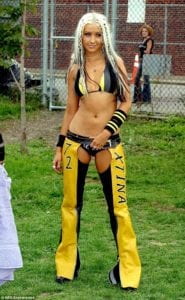
Significance: The purpose behind these chaps is to use one’s own body to collect rubbish. Whether that is when one is walking down the road or one has just eaten a candy bar and goes to dispose of it. The pockets are properly labeled to identify the recycled goods in China’s standards. As consumers, we are at the end of the chain of production- which is consumption. We are the final stop in the lives of the items that we consume and buy. Therefore, we are typically not aware of who, what, when how, and why things are being made every day. In what conditions was my pair of pants made? Who made them? How did they make them? What are they made of? Why did they use this material? How much are they getting paid to make these pants? How many raw materials were used in the production of these pants? These are questions that have come up throughout our research and throughout this semester as we have tackled and challenged recycling. We normally do not think about these issues and that is why we find ourselves in an ecological and sustainable crisis. If these pants were to be mass-produced and consumed, they would 1.) be the most sustainable piece of clothing because there was about 50-75 articles of plastic that went into the process and 2.) people would put them on and place themselves as the trash can in this position and think about their purchase/consumption and the role that they play as part of a huge waste cycle.
Design & Production: When I was scooping up garbage on the side of the mountains in Mongolia, I managed to scavage up a huge polyester bag that was previously used as a cement bag, and I placed all of the trash insides of it. I noticed that the material was sturdy, hard, and also waterproof because it was in perfect condition when I found it. To mimic this exact material, Vanelly and I decided to use plastic bags and heat them together over almost 7 layers. You can crumble, bend, and get this material wet because the plastic has melded enough to become an almost more resistant plastic. Here, we have basically recreated that park day and have made the cement bag the texture of the material and the plastic waste which was inside of it the material. These chaps are designed for all sorts of climate and weather patterns, not limited by any means! The fringes on the side are also made of plastic bags that have a degree of polyester in them. We started by taking a clear plastic bag as our base and then we began to cut and heat various pieces of plastic such as dabao bags, bubble wrap, plastic bags, and other interesting plastics that we found along the way. From the belt to the fringe on the sie, it is all plastic. The only thing that isn’t is the pockets that we made by taking a piece of cotton and sewing it to an old dabao insulated pizza box as well as using the laser printer to print out the stickers of the trash labels. Most of the work was done in heating the bags to the pants to make sure that the texture was hard enough and wouldn’t easily break by movement. The use of plastic bags was essential because it showcased all of the original trash that we consume. Like the saying goes: ‘you are what you eat’. This was a compilation of our eating, spending, and consuming habits reflected depict just how much plastic goes into making these products. We originally considered using pieces of textiles and sewing them together but I don’t think the idea articulates as a statement with textiles. We also had originally wanted to create pants or a variation of sweatpants but we decided to make chaps because of the fact that they are such a fun accessory but also as an extension of the body. Pants feel more personal because we wear them every day, so we thought to make something that could give others a fresh take and new approach to shed light on the issue of throwing trash away and keeping an eye on what trash we create.
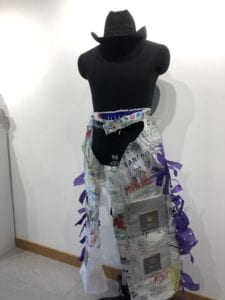
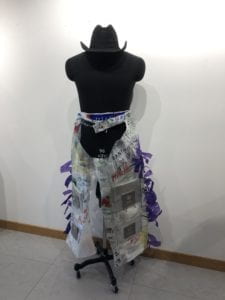
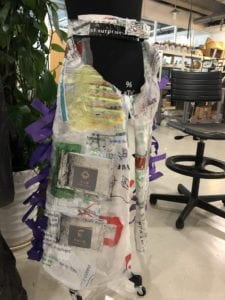
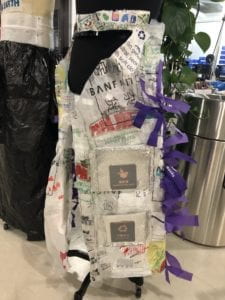
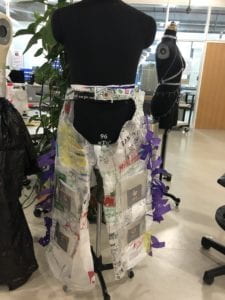
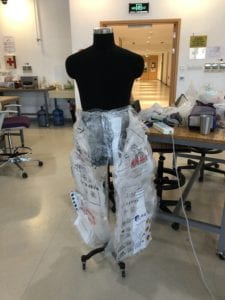
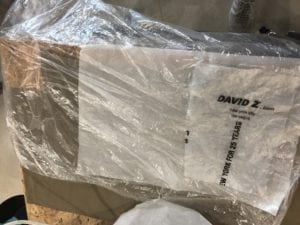
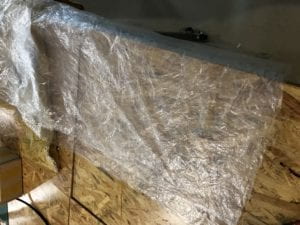
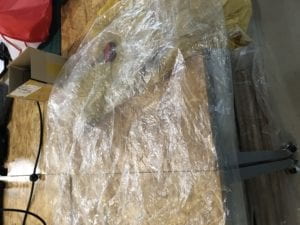
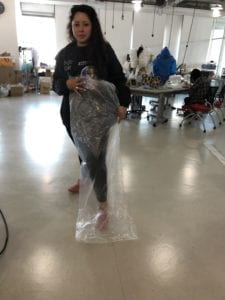
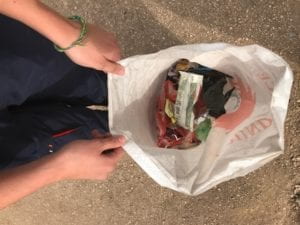
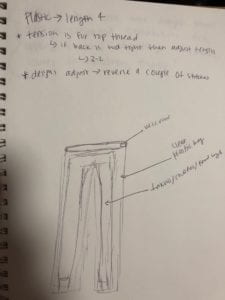
Conclusion: I do not know if I am ready to conclude this project. Vanelly and I were discussing creating a fringe vest top that can be a continuation of a line of ecologically conscious wearable couture. Maybe it could turn into a partnership with brands like Cheetos or Papa Johns because we utilized so many of their bags and products in the production. It is almost like a walking advertisement billboard of brands. Our goal was communicated throughout this entire process all the way up to the end. The only thing I would change if I were to go back is to find more pockets and make them blend more into the pants. I think the shiny material was too heavy of a contrast with the light plastic bags. I would have also done the fringe another material. I would have maybe made it out of the same material as everything else and heated plastic bags into little rectangles and then they would have blended in more cohesively. But I am glad how it turned out. The message is communicated clearly in the material and the pockets give it away. But I will argue that there is a lot going on, therefore causing subtle disconnects within understanding the greater overall purpose of using them as your own trash can. I think my favorite part was heating the bags together and waiting for the texture and feel to change drastically. It felt like faux leather that was indestructible. That is when I knew that we were finished heating bags because we knew that it reached the perfect sturdiness it needed to carry itself and a potential person. I would love to endeavor in a similar project again, and even create a follow-up piece to see the differences as a beginner and amateur tailer to now.

Leave a Reply